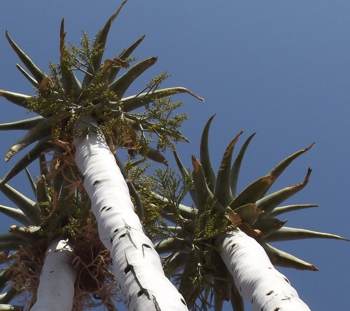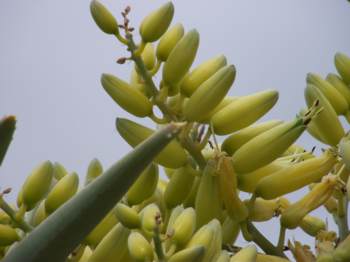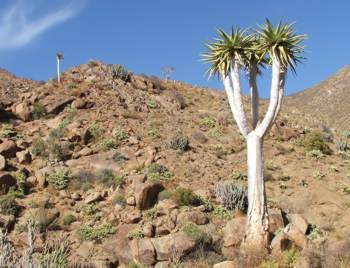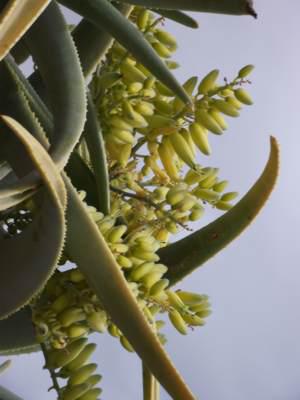Aloidendron pillansii
Aloidendron pillansii (L.Guthrie) Klopper & Gideon F.Sm. = Aloe pillansii L.Guthrie
Family: Asphodelaceae
Common names: giant quiver tree, bastard quiver tree (Eng.); reuse kokerboom, baster-kokerboom (Afr.)
SA Tree No: 30
Introduction
Aloidendron pillansii is arguably the scarcest of all tree aloes in southern Africa. It was previously called Aloe pillansii, however a new genus Aloidendron has been created for the tree aloes. This tree is synonymous with the extreme arid northwest of South Africa and the rugged mountainous parts of southern Namibia.

Description
Description
Aloidendron pillansii is a succulent tree that is impressively sculptured by time and the elements of the desert. From afar, they take the appearance of mysterious kings guarding the barren desert landscape and on close inspection their beautifully fissured golden bark, white pillar-like stems and pale green leaf crowns reveal a beauty that can only be appreciated in its natural habitat. Trees reach a stem height of 10m or more and a stem diameter ranging from 1-2m at the base narrowing to about 0.2m at the tip.

Characteristically, these trees branch dichotomously (forking regularly into two equal branches) from approximately midway up the length of the stem. The few to many branches are smooth, erect or slightly divergent. Stems in old specimens have swollen bottle-shaped trunks that support the tall branches. The stem is covered with a white powdery substance which is particularly visible in younger specimens. The bark at the base is a yellowish to brownish golden colour and peels away as the plant gets older leaving sharp edges along the lower half of the stem.
Leaves are densely rosulate (arranged in a rosette), curved, lance-shaped and tapering gradually, 500-600×100-120mm, and grey-green to brownish-green having a smooth surface above and below. Young leaves have a glaucous appearance which is also quite distinctive in comparison to closely-related species. Leaf margins have small white teeth of 1-2mm long and 5-8mm apart. Aloidendron pillansii is similar to A. dichotomomum though the former has broader and paler leaves with pendant yellow flowers while A. dichotomomum has narrower, darker leaves and upright inflorescences.

The two aloes also flower at different times of the year. Inflorescence of A. pillansii is approximately 0.5m long which spreads out somewhat horizontally carrying the upward turning racemes of up to 50 branches. The inflorescence that develops from in-between the lowest leaves hangs down separating it from A. dichotomomum and A. ramosissimum which carry their inflorescences in an erect fashion above the top of the leaf rosettes. The racemes are up to 150mm long and carry up to 30 yellow flowers at a time. Flowering starts from late spring in late September and the spherical capsules that ripen from December split open into three parts to release the papery seeds that are dispersed by wind.
Conservation Status
Status
Aloidendron pillansii was assessed and classified as an Endangered species according to the latest IUCN criteria (Loots 2005). The species is protected by the Nature Conservation Ordinance and listed on CITES Appendix 1. Its threats derive mainly from its small population size, low natural recruitment, illegal collecting, and habitat loss through mining, impact of livestock and climate change.
Distribution and habitat
Distribution description
Aloidendron pillansii occurs in barren and rugged mountainous areas associated with an arid climate that gets most of its rain in the winter. They are also found on low gravel slopes while others are found in or near dry river beds amongst large rocks. The few remaining populations are found in the extreme northwestern parts of the Northern Cape and the southwestern extremities of Namibia at altitudes ranging from 250-1000m.

Derivation of name and historical aspects
History
The genus name Aloidendron is a combination of Aloe and dendron - the latter referring to their tree like habit. Aloe is derived from the Arabic, `Alloch' and translated as `Allal' in Greek and Hebrew, literally meaning bitter or bitter sap, referring to aloe sap. The species was named by South African botanist Louise Guthrie (1879-1966) in 1928 to honor Neville S. Pillans, the well-known Cape botanist who first collected it at Cornell's Kop in the Richtersveld. The common name comes from a translation of the Afrikaans name `reuse kokerboom' which translates as giant quiver tree, alluding to its grotesque size and the hollowed stems of a related species ( Aloidendron dichotoma ) that were used to make quivers for arrows. An alternate common name sometimes seen but deemed politically incorrect and insulting is bastard quiver tree which makes reference to the Richtersveld region being one of the ‘baster states' (racially mixed people) of South Africa that was populated by biracial descendants of the indigenous African people and European settlers.
Mr Neville Stuart Pillans (1884–1964) from Rosebank, Cape Town was the only son of the agriculturist and horticulturist Eustace Pillans (1850–1919). He went to England to train in agriculture at the University of Cambridge, but never graduated due to ill health. His father was interested in gardening and enthusiastically collected and grew succulents at his Rosebank residence from where he communicated his collections to N.E. Brown at Kew. This resulted in several new species being described. Neville Pillans, who later joined the staff of the oldest herbarium in South Africa (est. 1865), namely the Bolus Herbarium in Cape Town, took over his collections and expanded them further to become one of the most eminent collectors of Stapeliads.
In 1910, Neville Pillans published in the Agricultural Journal advocating for the establishment of a botanical garden for indigenous flora at the Cape. He subsequently assisted Prof. H.H.W. Pearson in choosing the site for what is now the world-renowned Kirstenbosch National Botanical Garden. Pearson was the first director of Kirstenbosch. Interestingly, Neville Pillans also accompanied Prof. Robert Harold Compton (second director of the then National Botanical Gardens, 1919–1953) in 1920 on an exploratory journey across the Western Karoo in search for a suitable area for the establishment of a succulent Botanical Garden. This, Prof. Compton believed, could serve as an ‘outstation' or ‘substation' to Kirstenbosch for cultivating, studying and conserving arid and semi-arid flora as these plants were unsuitable to Kirstenbosch mainly due to its high rainfall. Pillans and Compton decided on a place called Whitehill near Matjiesfontein north of the Witteberg Mountain Range and the Karoo Gardens was established in 1921, making it the second oldest botanical garden of the present South African National Biodiversity Institute (SANBI).
Neville Pillans was thus instrumental in choosing the sites of two very important botanical gardens and such was his interest in South African botanical taxonomy that he published monographs on Restionaceae, Bruniaceae, Phylica, Agatashosma and Metalasia. Apart from Aloidendron pillansii, he is also commemorated in the genus Pillansia, as well as the species Carraluma pillansii, Eucomis pillansii, Duvalia pillansii, Huernia pillansii, Stapelia pillansii and Erica nevillei.
Ecology
Ecology
The bright yellow flowers produce nectar which is harvested by sugarbirds and ants. Generally, flowers are pollinated by birds, bees and ants. When capsules dry out, the winged seeds are carried by the wind, often landing in bushes where they germinate, making full use of the shelter and shade. Plants eventually outgrow these so called ‘nurse plants', killing them in the process. Tufts of grasses are the best known nurse plants for this species and provide excellent conditions for survival from seedling stage to juvenile stage. Since domestic livestock, such as fat-tailed sheep and goats, are herded within close proximity of this species, the grasses are normally the first group of plants that are grazed and sometimes taken out of the ecosystem. This impacts the chances of successful seed germination and subsequent natural recruitment of the species.
Good rains on an annual basis are needed in the first 3–5 years after the seeds have germinated. The succulent leaves and roots as well as the swollen fibrous stems act as water reservoirs in times of drought and the grey powder on the stems reflects intense heat away from the plant. Aloidendron pillansii develops long stems that grows erect and away from the hot rocky terrain and this in itself helps to keep the leafy crowns cool.
Out of the three related species namely A. pillansii, A. dichotoma and A. ramosissima, A. pillansii is most threatened and regarded as an endangered species. This is due to its highly localised habitat, small population size and low natural recruitment.
Furthermore, the species is under additional pressure arising from overgrazing, mining and therefore habitat loss and the effects of climate change in the form of erratic rainfall and prolonged episodes of drought. Although not fully understood, the impact of premature death of adult plants and possibly over collecting are further factors resulting in the decline of current populations. A comprehensive study of the current population trends and conservation biology is urgently needed in an effort to obtain a better grasp of the most likely future of this charismatic, noble and stately species.
Uses
Use
Aloe pillansii is not used for medicinal purposes and is unlikely to be associated with the cultural beliefs and traditions of the local Northern Cape people. However, the plants are revered by people for their old age, toughness and distinct synonymy with the Richtersveld. Plants are very much sought after for their architectural shape as gardens and container subjects. Its suitability to arid and semi-arid climates and scarcity has further added to the plant's trading value.

Growing Aloidendron pillansii
Grow
Aloe pillansii features quite prominently in private and public gardens all over southern Africa and other countries with a similar climatic conditions. In wetter parts of South Africa such as the Western Cape, these plants are grown in pots with well-drained soils. In the wetter months, the pots are simply moved under roof. A position in a hot and dry rock garden is best if one wants to grow this aloe in open ground but then only in a drier climate.
Plants such as Aloe dichotoma , A. ramosissima , Cotyledon orbiculata , Crassula arborescens , C. ovata , Cyphostemma juttae , C. curorri and Tylecodon paniculata , together with other perennials like mesembs and geophytes, are ideal companion plants to the giant quiver tree. Planted together they will completely transform any garden. Large potted giant quiver trees are very rewarding as they make beautiful specimens when positioned to enhance entrances, walls, courtyards, patios etc. Always use a good quality, loamy sandy soil with plenty of drainage chips at the bottom of containers. Mix bone meal into the soil to help feed the fleshy roots of plants.
Plants are best grown from seeds planted in autumn, (March, April) in trays of coarse river sand. Care must be taken not to water too much and seedlings can be potted once about 30–50 mm or about 3 years of age.
References
- Carter, S., Lavranos, J., Newton, L. & Walker, C. 2011. Aloes. The definitive guide . Royal Botanic Gardens, Kew.
- Curtis, B. & Mannheimer C. 2005. Tree Atlas of Namibia . National Botanical Research Institute, Windhoek.
- Glen, H.F. & Germishuizen, G. (compilers) 2010. Botanical exploration of southern Africa, edition 2. South African National Biodiversity Institute, Pretoria.
- Reynolds, G.W. 1950. The aloes of South Africa . Cape Times, Parow.
- Van Wyk, B-E. & Smith, G. 1996. Guide to the aloes of South Africa. Briza, Pretoria.
- http://www.plantzafrica.com/plantab/aloedichotoma.htm
- http://www.smgrowers.com
- Grace, OM; Klopper, RR; Smith, GF; Crouch, NR; Figueiredo, E; Ronsted, N; van Wyk, AE 'A revised generic classification for Aloe (Xanthorrhoeaceae subfam. Asphodeloideae).' Phytotaxa 76:1 (2013): 7-14
Credits
Werner Voigt
Karoo National Botanical Garden, Worcester
February 2014
Plant Attributes:
Plant Type: Succulent, Tree
SA Distribution: Northern Cape
Soil type: Sandy
Flowering season: Spring, Early Summer
PH: Acid, Neutral
Flower colour: Yellow
Aspect: Full Sun
Gardening skill: Challenging
Special Features:
Horticultural zones







Rate this article
Article well written and informative
Rate this plant
Is this an interesting plant?
Login to add your Comment
Back to topNot registered yet? Click here to register.